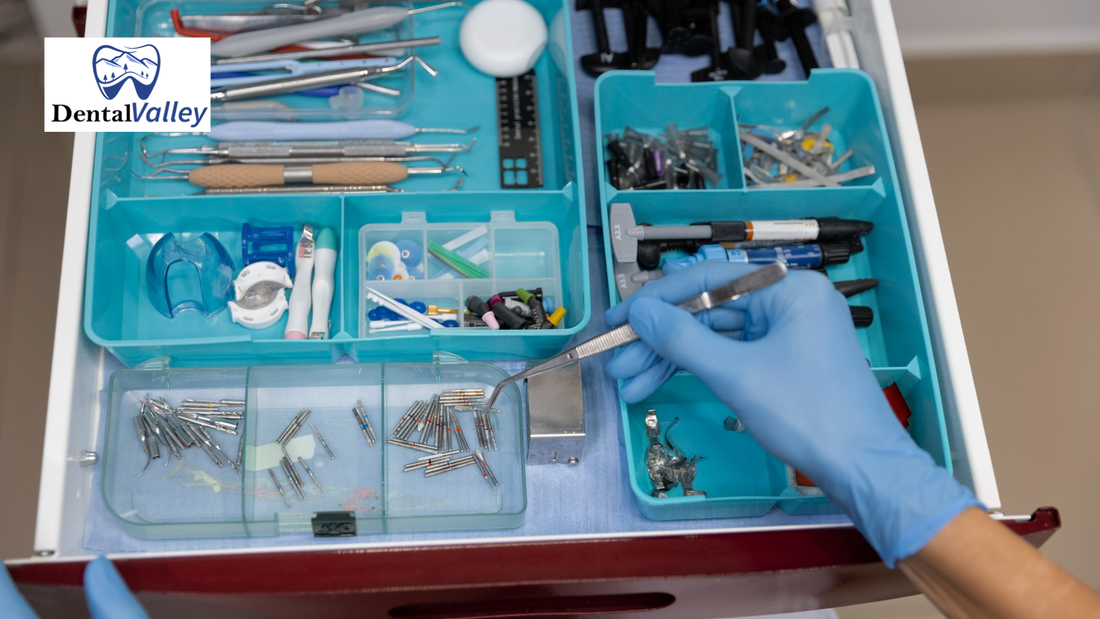Every smooth dental implant procedure begins with a well-prepared tray. A meticulously arranged surgical tray setup is more than convenience, it’s the foundation of procedural accuracy and control.
The right setup minimizes surgical stress, supports team coordination, and ensures every tool is available when precision is non-negotiable.
In this detailed guide, we’ll get you through how to build a perfect surgical tray setup that enhances efficiency, keeps the focus on precision, and contributes directly to predictable implant outcomes.
The Power of a Well-Organized Surgical Tray Setup
A disorganized tray creates moments of distraction that break surgical flow. In implantology, even a three-second delay searching for a tool can interrupt concentration and affect accuracy.
A structured tray setup keeps instruments sterile, accessible, and sequence-ready.
Clinics that prioritize organized setups report:
• Faster surgical turnover times
• Smoother communication between surgeon and assistant
• Consistently improved procedural accuracy
Having dedicated tray systems for dental implant surgeries also streamlines staff training and helps new clinicians adapt faster to your workflow.
Key Principles of a Well-Organized Tray
An efficient tray is built on three critical pillars: accessibility, sterility, and sequencing.
1. Accessibility ensures tools are visible and in reach, critical for maintaining workflow rhythm.
2. Sterility safeguards patient safety, preventing infection or post-op inflammation.
3. Sequencing aligns instruments according to order, minimizing confusion under stress.
Clinically, this results in minimal handling, clear positioning, and color-coded identification wherever possible.
Step-by-Step: Building the Perfect Surgical Tray Setup
Step 1: Define Procedure Type & Components Needed
No two implant surgeries require the same components. Start by defining the surgical category: single-unit, multiple-unit, or best full mouth dental implants placement. This determines what major instruments, drills, and connectors you’ll need.
• For single implants: include pilot and final drills, handpiece accessories, and screw implant components.
• For multi-unit or full-arch cases: prepare abutment kits, torque wrenches, and guiding templates.
• For limited ridge cases: ensure availability of narrow dental implant kits designed for precision placement in dense bone.
Step 2: Organize Instrument Zones
Divide your tray into logical sections:
• Primary Zone: frequently used items like scalpel blades, periosteal elevators, and suction tips
• Secondary Zone: implant-specific tools such as drills, drivers, and guided sleeves
• Accessory Zone: auxiliary elements such as gauze, sutures, and irrigation items
Pre-surgical inspection ensures each tool is functional and sterilized.
Step 3: Prepare Implant and Prosthetic Attachments

Implant prosthetic integration is a detailed process that requires precise placement of tools. Ensure that healing components, abutments, and attachments are arranged according to the procedure’s timeline.
Essential components include:
• Prosthetic abutment and healing collar sets
• Driver tips and torque-controlled handles
• Abutment screws with assigned positions
For removable restoration cases, keep dental ball attachments grouped in dedicated slots for easier access.
Step 4: Consider Material and Storage Sterility
All metallic tools like those made from titanium or stainless steel should undergo ultrasonic cleaning before sterilization. Using autoclavable cassettes helps maintain setup integrity.
The handling of titanium dental implant kits demands special attention: position them in a labeled cassette with sequence markings to maintain procedural traceability.
Sterile packaging from reputable dental implant equipment suppliers reduces contamination risks while ensuring compliance with ISO-certified sterilization standards.
Step 5: Label and Color-Code Instruments
The efficiency of a tray often depends on visual cue systems. Labeling each section based on the surgical phase helps assistants retrieve tools instantly.
Color coding enhances coordination. For example:
• Blue-coded handles: incision instruments
• Yellow-coded grips: drilling
• Green-coded areas: component placement
A structured labeling approach strengthens team synchronization, especially in time-sensitive implant cases.
Understanding the Surgical Sequence
Every implant surgery has a natural rhythm and your tray should mirror that rhythm.
|
Surgical Stage |
Essential Tools |
Purpose |
|
Incision |
Scalpels, elevators |
Flap access |
|
Bone preparation |
Burs, drills, irrigation tubes |
Osteotomy creation |
|
Implant placement |
Drivers, torque tools, fixation kits |
Fixture seating |
|
Abutment connection |
Healing or Castable dental abutment |
Soft tissue cover |
|
Closure |
Sutures, retractors |
Final soft tissue management |
Consistent sequencing contributes to faster operative times and greater concentration during complex procedures.
Step 6: Integrate Emergency Supplies

Even the most prepared surgeries can present unexpected challenges. Include a dedicated emergency subset tools within your tray system
A controlled layout ensures rapid access during unforeseen complications, preserving surgical calmness and patient confidence.
Step 7: Stock Backup Components
Running out of essentials during a live operation introduces unnecessary tension. Maintain at least one spare per critical component type, especially for torque drivers, drills, and dental implant connectors.
Collaborating with a certified dental implant distributor makes replenishment simpler, ensuring consistent quality of critical parts such as guide sleeves and analogs.
By maintaining steady supply through trusted channels, clinics ensure efficiency even for back-to-back surgical days.
Clinicians often integrate backup planning into larger workflow streams, echoing surgical best practices illustrated in stress-free implant procedure guides focused on preoperative precision and control.
Step 8: Minimize Tray Overload
Extra instruments can confuse assistants and can make slight delays. Include only what is essential for a given case.
For critical elements like castable abutment screws or adapter drivers, each piece should sit within natural arm reach when seated chairside.
Step 9: Post-Surgical Tray Management
Post-procedure cleanliness ensures instrument longevity. Ultrasonic cleaning, followed by autoclaving, removes biological residues without damaging fibers or edges.
Tools like drills and drivers benefit from individual slot protection after cleaning.
Building sustainable post-use processes extends tool life and eases future setups, reducing costs for clinics while maintaining high-standard aesthetics for safe and successful dental implants procedures.
Advanced Tips for Precision and Efficiency

1. Perform a dry run: Simulate the surgical procedure before the patient arrives.
2. Follow exact torque protocols: Maintaining the integrity of mechanical components such as guide sleeves and screw implant parts improves consistency across implants.
3. Standardize kits: Clinic uniformity ensures staff familiarity with the tools, reducing preparation errors.
4. Track tools digitally: Modern inventory software integrated with dental implants products supply databases can help track sterilization dates and replacement intervals.
5. Stay updated: Regularly compare tool durability and upgrade pathways with certified sources like dental implants channels for long-term product reliability evaluation.
Common Setup Mistakes and How to Avoid Them?
Even experienced clinicians fall into avoidable setup errors. Key mistakes include:
• Overpacking trays with redundant tools
• Ignoring torque calibration verification
• Inadequate labeling causing confusion mid-procedure
• Using mismatched components from varying systems
• Poor sequencing that creates procedural lag
Avoiding these through preparation protects both surgical integrity and team confidence.
Comparison: Organized vs. Unstructured Surgical Tray
|
Parameter |
Organized Setup |
Unstructured Setup |
|
Sterility |
Maintained in sequence |
High risk of contamination |
|
Surgical speed |
Faster transitions |
Slower instrument retrieval |
|
Concentration |
Fully sustained |
Prone to interruptions |
|
Inventory tracking |
Clear and automated |
Manual and error-prone |
|
Stress level |
Low |
High |
Organization drives excellence—procedures become smoother, and patient confidence soars.
Quick FAQ Section
Q: How do you organize a dental implant surgical tray?
A: Arrange instruments by surgical phase: incision, drilling, implant placement, abutment connection, and closure. Use color codes and ensure sterile separation.
Q: What makes a surgical tray efficient?
A: Simplicity, sequencing, and sterilization. Tools should be in reach, clearly marked, and in procedural order for fast, error-free handling.
Q: How to prevent cross-contamination in implant tools?
A: Use sealed, sterilized packs and separate trays for each patient. Always verify autoclaving cycles and storage integrity.
Q: Are reusable instruments safe for implants?
A: Yes, when properly sterilized and maintained. Many top dental implants systems are designed for longevity through high-grade titanium and corrosion-proof coatings.
Q: What is the ideal tray setup for limited bone cases?
A: Include narrow dental implant drills, specialized adapters, and torque-controlled drivers to ensure precision in restricted ridge zones.
Building Confidence Through Organized Preparation
A meticulously prepared tray reflects professional discipline. It reduces anxiety for the surgeon and reinforces trust from assistants and patients alike.
Organization transforms complex implant procedures into calm, coordinated sequences every motion, every tool exactly where it should be.
The synergy between premium surgical tools and thoughtful workflow design brings lasting value to implant dentistry.
Choosing quality products from trusted brands like Dental Valley ensures that every tray you prepare contributes to a stress-free, predictable surgical experience.
At Dental Valley, we offer high-performance surgical instruments designed for implant efficiency that can transform your setup into a symbol of surgical confidence.
Perfect organization. Seamless teamwork. Consistent results; that’s the rhythm of every great surgery.

